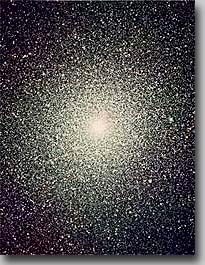
Term 10 course for MPhys students and MSc students in
Astronomy.

Twinkle, twinkle, little star,
Now I know just what you are:
An incandescent ball of gas
Condensing to a solid mass.
(This sums up the whole of stellar structure and
evolution in two lines!)
(Thanks to Melinda Watson, Arizona, for telling me that this was written by her grandfather, George W. Bunton, Director of Morrison Planetarium, Academy of Sciences in San Francisco (1951-1962), for a Morrison Planetarium show. She also told me the original version, which is what is now quoted above; the second line differs slightly from what I had been quoting ("I know exactly what you are"). Updated 23 February 2009.)
This course consists of about 18 lectures and 8 discussion or examples classes, which form an integral part of the course. The lectures are divided into six sections and the assessment consists of four problem sheets and an unseen summer examination. The material in the lecture notes defines the course for examination purposes. Note that the lecture notes have gaps in them, where sketches or mathematics have been omitted - these gaps will be filled in on the blackboard during lectures. Complete versions of the mathematics will be provided here after we have reached the end of each section.
The lectures will be mainly presented on power-point, and these power-points are also available here, but they also have gaps in them - they give a summary of the material, and details will be presented on the blackboard. The full versions of the printed lecture notes will be definitive for the syllabus, and not everything in them will be mentioned in lectures.
The main books on the reading list are:
The Stars: their Structure and Evolution, by R J Tayler (CUP 1994) - worth
buying
An Introduction to the Theory of Stellar Structure and Evolution, by D Prialnik
(CUP 2000; 2nd edition 2010)
Introduction to Stellar Astrophysics, by E Boehm-Vitense (you will want
volumes 1 and 3 of the 3-volume set, published by CUP in 1989 and 1992)
You might also find it helpful to read chapters 8, 9 and 10 of my own book, Observational Astrophysics, by R C Smith (CUP 1995); these chapters give a succinct overview of the properties and structure of stars and of how they evolve, and could be usefully read before the course as background material, or afterwards for revision.
All these books are in the University Library.
The course document, teaching timetable, handouts, lectures and problem sheets,
all in Word or pdf format,
can be accessed during the course via the following links.
All material except the lecture notes and powerpoints will be handed out in printed format at the appropriate lecture.
Course document
Teaching timetable
Section 1 - full version
Powerpoint of lecture 1
Powerpoint of Seminar 1
Powerpoint of lecture 2
Powerpoint of lecture 3
Section 2 - full version
Proofs of Theorems I to IV
Powerpoint of lecture 4
Section 3 - full version
Powerpoint of lecture 5
Powerpoint of lecture 6
Powerpoint of lecture 7
Powerpoint of lecture 8
Radiative Transfer handout
Powerpoint of lecture 9
Section 4 - full version
Powerpoint of lecture 10
Powerpoint of lecture 11
Powerpoint of lecture 12
Section 5 - full version
Powerpoint of lecture 13
Powerpoint of lecture 14
Powerpoint of lecture 15
Powerpoint of lecture 16
Powerpoint of lecture 17
Powerpoint of lecture 18
Section 6 - full version
Handout 1
Handout 2
Handout 3
Handout 4
Handout 5
Handout 6
Handout 6A
Handout 7
Handout 8
Handout 9
Handout 10
Handout 11
Handout 12
Handout 13
Handout 14
Handout 15
Handout 16
Handout 17
Handout 18
Problem Sheet 1 Due at 4.00 pm on Thursday 20 October 2011,
at the Department Office, Pev II, 3A20 (FRO: 12 noon Friday 21 October)
Problem Sheet 2 Due at 4.00 pm on Thursday 3 November 2011,
at the Department Office, Pev II, 3A20 (FRO: 12 noon Friday 4 November)
Problem Sheet 3 Due at 4.00 pm on Thursday 17 November 2011,
at the Department Office, Pev II, 3A20 (FRO: 12 noon Friday 18 November)
Problem Sheet 4 Due at 4.00 pm on Thursday 1 December 2011,
at the Department Office, Pev II, 3A20 (FRO: 4 pm Thursday 1 December)
Sample summer examination paper : This sample paper is in the same format as the unseen paper you will sit in May, and as the unseen papers set in 2008, 2009, 2010 and 2011. The Section A questions are at a similar level to the questions on an example sheet; the Section B questions are shortened versions of the questions in the 2007 exam paper, which had a different format, as did earlier papers.
All the powerpoint lectures contain a slide at the beginning summarising the contents of the lecture. I have gathered these all together in a file called Lecture Summaries which will act as an extended summary of the syllabus, which you may find useful for revision.
Site maintained by Robert Smith
Last updated 28 November 2011